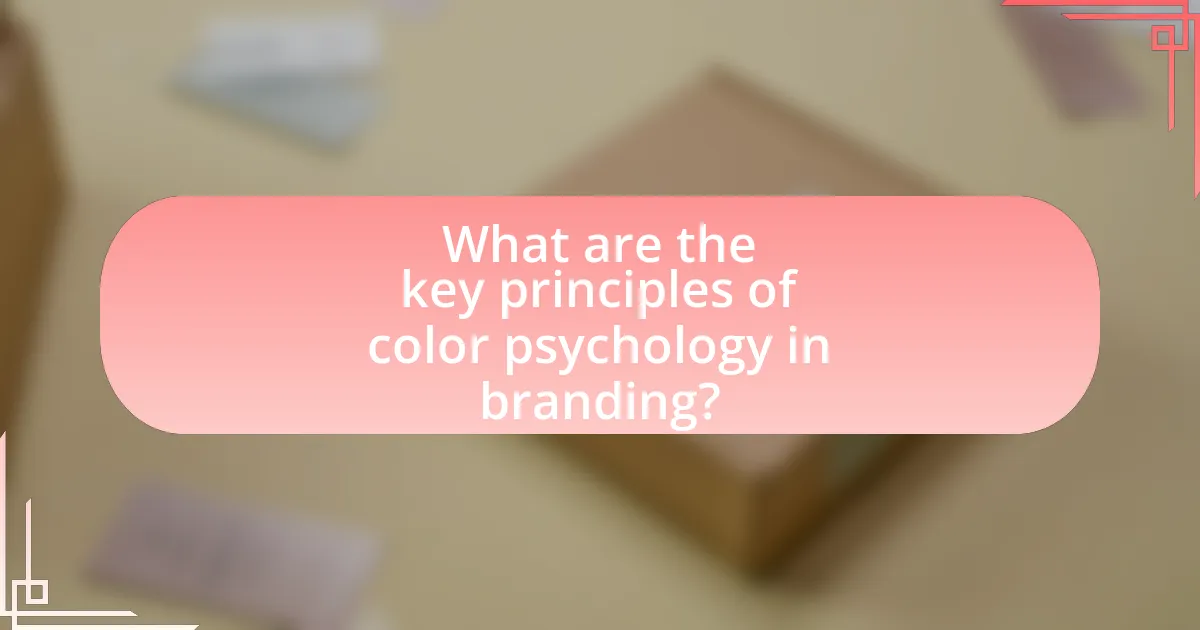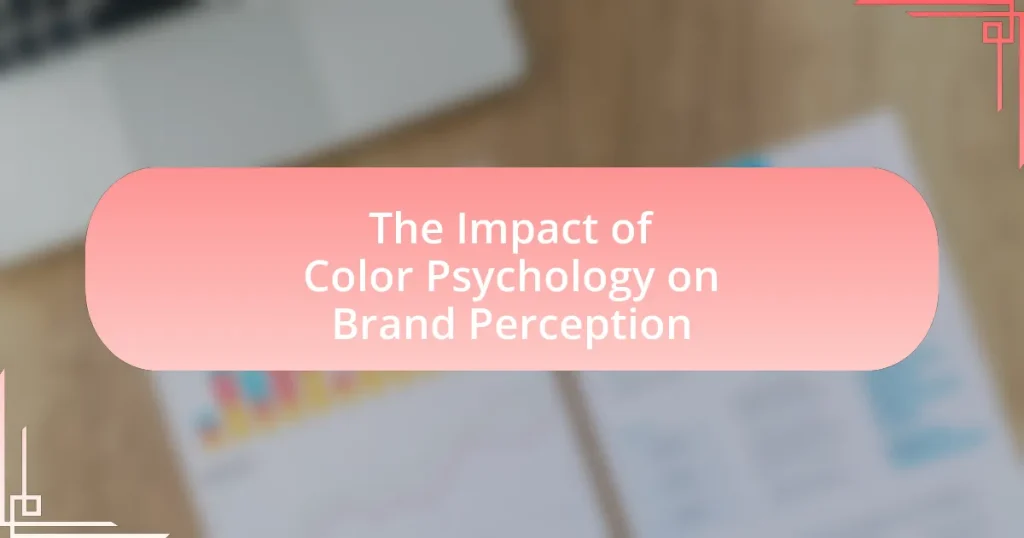The article examines the impact of color psychology on brand perception, highlighting how colors influence consumer emotions and behaviors. It discusses the psychological effects of different colors, cultural differences in color interpretation, and the importance of color in branding and recognition. Key principles of color psychology, strategies for effective color selection, and examples of successful and failed color usage in branding are also explored, emphasizing the critical role color plays in shaping consumer decisions and brand loyalty.

What is the Impact of Color Psychology on Brand Perception?
Color psychology significantly influences brand perception by affecting consumer emotions and behaviors. Research indicates that colors can evoke specific feelings; for instance, blue often conveys trust and reliability, while red can evoke excitement and urgency. A study by the University of Loyola found that color increases brand recognition by up to 80%, demonstrating its critical role in consumer decision-making. Additionally, brands like Coca-Cola and Tiffany & Co. effectively utilize color to create strong emotional connections, reinforcing their brand identity and consumer loyalty.
How does color influence consumer emotions and behaviors?
Color significantly influences consumer emotions and behaviors by evoking specific psychological responses that can affect purchasing decisions. For instance, research indicates that colors like red can create a sense of urgency, often leading to impulse buying, while blue tends to evoke feelings of trust and security, encouraging consumers to engage with a brand. A study published in the journal “Management Decision” found that up to 90% of snap judgments made about products can be based on color alone, demonstrating its critical role in brand perception and consumer choice.
What psychological effects do different colors have on individuals?
Different colors evoke specific psychological effects on individuals, influencing emotions and behaviors. For example, red often stimulates excitement and urgency, making it effective in marketing to encourage quick decisions. Blue tends to promote calmness and trust, which is why many financial institutions use it in branding. Yellow can evoke feelings of happiness and optimism, but excessive use may lead to anxiety. Green is associated with nature and tranquility, often used to convey health and wellness. Research by Satyendra Singh in the “Management Decision” journal highlights that color can increase brand recognition by up to 80%, demonstrating its significant impact on consumer perception and behavior.
How do cultural differences affect color perception?
Cultural differences significantly affect color perception, influencing how individuals interpret and respond to colors based on their cultural backgrounds. For instance, in Western cultures, white is often associated with purity and weddings, while in many Eastern cultures, it symbolizes mourning and funerals. This divergence in color symbolism can impact branding strategies; companies must consider these cultural associations to effectively communicate their messages. Research by Aslam (2006) in the Journal of Fashion Marketing and Management highlights that color preferences vary across cultures, with specific colors eliciting different emotional responses depending on cultural context. Therefore, understanding these cultural nuances is essential for brands aiming to resonate with diverse audiences.
Why is color important in branding?
Color is important in branding because it influences consumer perception and emotional response, ultimately affecting purchasing decisions. Research indicates that up to 90% of snap judgments about products can be based on color alone, highlighting its significant role in brand recognition and differentiation. For instance, a study by the Institute for Color Research found that people make a subconscious judgment about a person, environment, or product within 90 seconds of initial viewing, with color being a key factor in that assessment. This demonstrates that effective use of color can enhance brand identity and foster customer loyalty.
What role does color play in brand recognition?
Color plays a crucial role in brand recognition by influencing consumer perceptions and emotions associated with a brand. Research indicates that color can increase brand recognition by up to 80%, as it helps create a visual identity that consumers can easily recall. For instance, brands like Coca-Cola and McDonald’s effectively use red and yellow, respectively, to evoke feelings of excitement and happiness, which enhances their memorability. This connection between color and emotional response is supported by studies, such as those conducted by the Institute for Color Research, which found that people make a subconscious judgment about a product within 90 seconds of initial viewing, with 62-90% of that assessment based solely on color.
How can color choices enhance brand loyalty?
Color choices can enhance brand loyalty by creating emotional connections and fostering recognition among consumers. When brands consistently use specific colors, they evoke particular feelings and associations; for instance, blue often conveys trust and reliability, while red can evoke excitement and urgency. Research indicates that color increases brand recognition by up to 80%, which reinforces consumer familiarity and preference. This familiarity leads to a stronger emotional bond, as consumers are more likely to choose brands that resonate with their personal values and feelings, ultimately driving repeat purchases and loyalty.

What are the key principles of color psychology in branding?
The key principles of color psychology in branding include the emotional associations of colors, the influence of color on consumer behavior, and the importance of color consistency in brand identity. Colors evoke specific feelings; for instance, blue often conveys trust and reliability, while red can evoke excitement and urgency. Research indicates that up to 90% of snap judgments about products can be based on color alone, highlighting its significant impact on consumer decisions. Additionally, maintaining consistent color schemes across branding materials strengthens brand recognition, as studies show that consistent branding can increase revenue by up to 23%.
How do different colors convey specific brand messages?
Different colors convey specific brand messages by evoking distinct emotional responses and associations in consumers. For instance, blue often represents trust and reliability, making it a popular choice for financial institutions like banks. Red, on the other hand, is associated with excitement and urgency, frequently used in clearance sales to stimulate quick purchasing decisions. Research by the Institute for Color Research indicates that color can increase brand recognition by up to 80%, highlighting its significant role in consumer perception. Thus, brands strategically select colors to align with their desired message and influence consumer behavior effectively.
What emotions are commonly associated with primary colors?
Primary colors are commonly associated with specific emotions: red evokes passion and energy, blue signifies calmness and trust, and yellow represents happiness and optimism. These associations are rooted in color psychology, which suggests that colors can influence human emotions and behaviors. For instance, studies have shown that red can increase heart rates and stimulate excitement, while blue is often linked to feelings of serenity and reliability. Yellow, being bright and attention-grabbing, is frequently connected to joy and positivity. These emotional responses to primary colors play a significant role in branding and marketing strategies, as companies leverage these associations to shape consumer perceptions and behaviors.
How do secondary colors impact brand perception?
Secondary colors significantly influence brand perception by evoking specific emotions and associations that can enhance or detract from a brand’s identity. For instance, green, a secondary color, is often associated with growth and health, making it effective for brands in the wellness and environmental sectors. Research indicates that colors can increase brand recognition by up to 80%, highlighting the importance of color choices in marketing strategies. Additionally, a study published in the Journal of Business Research found that color combinations, including secondary colors, can affect consumer trust and loyalty, demonstrating their critical role in shaping brand perception.
What are the common color schemes used in branding?
Common color schemes used in branding include monochromatic, analogous, complementary, triadic, and tetradic schemes. Monochromatic schemes utilize variations of a single color, creating a cohesive and harmonious look. Analogous schemes involve colors that are next to each other on the color wheel, promoting a serene and comfortable feel. Complementary schemes use colors opposite each other on the wheel, providing high contrast and vibrant visuals. Triadic schemes consist of three evenly spaced colors, offering balance and diversity. Tetradic schemes involve two complementary color pairs, allowing for rich color combinations. These schemes are strategically chosen based on color psychology principles, influencing consumer perception and emotional response to brands.
What is the significance of monochromatic color schemes?
Monochromatic color schemes are significant because they create a cohesive and harmonious visual experience, enhancing brand identity and recognition. By utilizing variations in lightness and saturation of a single color, brands can evoke specific emotions and convey a clear message. Research indicates that colors can influence consumer behavior; for instance, a study by Satyendra Singh published in the Journal of Marketing Research found that color increases brand recognition by up to 80%. This underscores the effectiveness of monochromatic schemes in establishing a strong, memorable brand presence.
How do complementary colors enhance brand appeal?
Complementary colors enhance brand appeal by creating visual contrast that attracts attention and fosters memorability. This contrast makes brands more recognizable and can evoke specific emotional responses, which are crucial for consumer engagement. For instance, research indicates that color combinations can influence purchasing decisions; a study published in the Journal of Business Research found that color contrast significantly affects brand perception and consumer behavior. By utilizing complementary colors, brands can effectively differentiate themselves in a crowded market, leading to increased brand loyalty and consumer trust.

How can brands effectively utilize color psychology?
Brands can effectively utilize color psychology by strategically selecting colors that evoke specific emotions and associations relevant to their target audience. For instance, research indicates that colors like blue can instill a sense of trust and dependability, making it a popular choice for financial institutions, while red can create a sense of urgency, often used in clearance sales. A study by the Institute for Color Research found that color increases brand recognition by up to 80%, highlighting the importance of color in consumer decision-making. By aligning their color choices with the psychological effects of colors, brands can enhance their identity and influence consumer behavior.
What strategies can brands implement to choose the right colors?
Brands can implement several strategies to choose the right colors, including understanding target audience preferences, analyzing color psychology, and conducting A/B testing. By researching demographic data, brands can identify colors that resonate with their specific audience, as different cultures and age groups may have varying associations with colors. For instance, blue is often associated with trust and reliability, making it a popular choice for financial institutions. Additionally, brands can leverage color psychology principles, which suggest that colors evoke specific emotions and behaviors; for example, red can stimulate appetite, making it effective for food brands. Finally, conducting A/B testing allows brands to evaluate how different color schemes perform in real-world scenarios, providing data-driven insights into consumer preferences and engagement levels.
How can market research inform color selection?
Market research can inform color selection by identifying consumer preferences and emotional responses associated with different colors. For instance, studies show that colors can evoke specific feelings; blue often conveys trust, while red can stimulate excitement. By analyzing data from surveys, focus groups, and consumer behavior studies, brands can determine which colors resonate most with their target audience. Research conducted by the Institute for Color Research indicates that up to 90% of snap judgments made about products can be based on color alone, highlighting the importance of aligning color choices with consumer expectations and psychological triggers.
What role does target audience play in color choice?
The target audience significantly influences color choice in branding and marketing. Different demographics respond uniquely to colors based on cultural, psychological, and emotional associations. For instance, research indicates that 85% of consumers make purchasing decisions based on color alone, highlighting its importance in appealing to specific audience segments. Additionally, colors evoke distinct feelings; for example, blue often conveys trust and reliability, making it popular among financial institutions targeting a professional audience. Understanding these preferences allows brands to tailor their color schemes effectively, enhancing brand perception and consumer engagement.
What are some examples of successful color usage in branding?
Successful color usage in branding can be seen in companies like Coca-Cola, which utilizes red to evoke excitement and energy, and Tiffany & Co., which employs a distinctive robin’s egg blue to convey luxury and sophistication. Coca-Cola’s red color has been integral to its identity since the late 19th century, contributing to its recognition and emotional connection with consumers. Similarly, Tiffany & Co.’s blue box has become synonymous with elegance and exclusivity, reinforcing the brand’s premium positioning in the jewelry market. These examples illustrate how strategic color choices can significantly influence brand perception and consumer behavior.
How have major brands leveraged color psychology effectively?
Major brands have effectively leveraged color psychology by strategically selecting colors that evoke specific emotions and associations aligned with their brand identity. For instance, Coca-Cola uses red to convey excitement and energy, which resonates with its brand image of fun and refreshment. Similarly, Tiffany & Co. employs a distinctive shade of blue, known as “Tiffany Blue,” to evoke feelings of luxury and exclusivity, reinforcing its premium positioning in the jewelry market. Research indicates that color can increase brand recognition by up to 80%, highlighting its critical role in consumer perception and decision-making.
What lessons can be learned from brands that failed in color selection?
Brands that failed in color selection demonstrate the critical importance of aligning color choices with target audience perceptions and cultural meanings. For instance, the rebranding of Tropicana in 2009, which involved a drastic change in packaging color and design, led to a 20% drop in sales within two months, highlighting how consumers can reject a brand when its visual identity does not resonate with their expectations. Additionally, the failure of Gap’s logo redesign in 2010, which was met with public backlash, underscores the necessity of consumer feedback in the design process. These examples illustrate that brands must conduct thorough market research and consider psychological associations of colors to avoid alienating their customer base.
What best practices should brands follow when applying color psychology?
Brands should select colors that align with their brand identity and target audience to effectively apply color psychology. This involves understanding the emotional and psychological associations of colors; for example, blue often conveys trust and professionalism, while red can evoke excitement and urgency. Research indicates that 85% of consumers make purchasing decisions based on color, highlighting the importance of color choice in branding. Additionally, brands should maintain consistency in color usage across all platforms to reinforce brand recognition and recall. This consistency helps create a cohesive brand image, which is crucial for consumer trust and loyalty.


